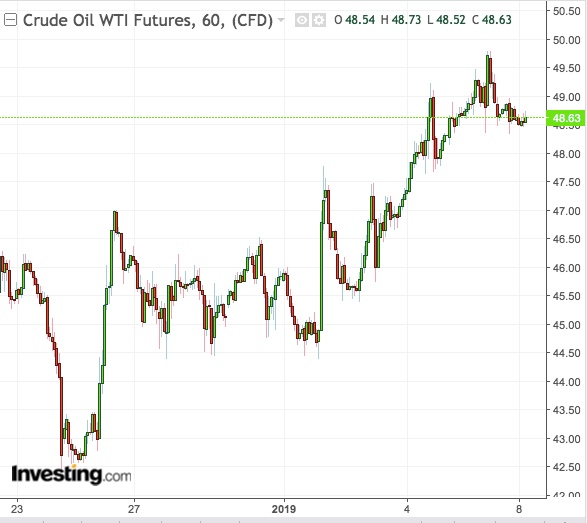Last year’s oil story was all about oversupply. This year’s story might be all about demand from China—or rather, the lack of it.
Just when oil bulls thought they had it all to drive the market up in 2019—aggressive Saudi output cuts and a kinder Federal Reserve that might not raise interest rates as previously foreseen—uncertainty about the global economy, particularly China, is holding back the rally in crude prices.
A Market Struggling To Rally
West Texas Intermediate crude is up around $6 per barrel or 14 percent from the 18-month lows hit on Christmas Eve.

But those gains haven’t come easy. Almost every session since January 2 has been wracked with volatility, with the market struggling to hold to early gains toward the close. Monday was a perfect example, with WTI again failing to test the key $50 resistance despite closing in on the target for two sessions in a row.
Energy Aspects and Goldman Sachs, two esteemed research houses for oil, are in no doubt as to what they believe will be the market’s Achilles heel this year: weaker China buying.
In a note issued Monday, analysts at London-based Energy Aspects said:
“China is undoubtedly the biggest concern, especially given the weakness in the latest economic data. Unsurprisingly, China's crude buying is set to soften in the near term, following record imports in November and still elevated arrivals in December.”
China Demand Growth Seen 26% Lower
Goldman Sachs analysts, led by the Wall Street bank’s commodities team heads Damien Courvalin and Jeffrey Currie, said in a client advisory also issued on Monday that China’s oil demand growth was expected to drop by 26 percent to 350,000 barrels per day year-on-year in 2019, from 475,000 bpd in 2018. On the contrary, emerging market demand outside China was expected to recover as Brazil, Turkey, South Africa and Russia came out of recession, they said.
But aren’t the US and China holding trade talks this week and aren’t they likely to achieve a deal of sorts? Yes and no.
The fact that a high-level US negotiation team led by Deputy Trade Representative Jeffrey Gerrish and Treasury Undersecretary for International Affairs David Malpass were in Beijing for the meeting, and that Chinese Vice Premier Liu put in a surprise appearance, were all good signs for the talks.
US-Sino Trade Talks Not A Done Deal Yet
But given the arduous list of trade issues between the two nations and the boiling point reached in their ties before the 90-day truce agreed to by President Donald Trump and his Chinese counterpart Xi Jinping on December 1, it is never safe to assume a deal is done until it is, well, done.
Energy Aspects flagged the importance of the ongoing talks in Beijing, saying the considerable and difficult-to-quantify downside risks from the US-Sino trade war uncertainties were starting to hit corporate earnings in China. It added:
“The (Chinese) government is taking measures to put a floor under growth, but this will take time.”
But in the meantime, the stuttering Chinese economy was having a knock-on effect throughout Asia, it said. The malady includes the collapse of China’s ESPO, Lula and Djeno crude differentials to the UK global benchmark Brent as the country’s smaller domestic refiners, known as “teapots”, decided to process the ample supplies in hand rather than import further.
From Refinery Woes To Brittle Market Sentiment In China
The larger refineries in China, meanwhile, were in no rush to restock substantially, given the expectations of weak demand growth in the first quarter, China’s Lunar New Year festival in February—which often results in holidays of up to a week long—and a hefty maintenance schedule in April.
All that came on top of the already brittle market sentiment since late December, after the sacking of the head trader at state refining giant Unipec for losses that have left the local trading community extremely cautious toward risk taking.
To sum it all up, Energy Aspects said:
“For the oil market, there are only two prices that truly matter: the price at which supply gets shut in (below $50 per barrel Brent), and the price at which demand is destroyed (over $90-100 per barrel Brent). Every other price in between those two prices is merely a function of what people are willing to pay for it.”
Current Demand Growth Historically Associated With Recessions
The agency added:
“Peering deeper into 2019, the supply side seems less of a concern: OPEC is cutting production, lower oil prices will help to rationalize US production growth, the industry continues to under-invest, and there are numerous problem spots to worry over. In short, we do not see an oversupply situation emerging from the supply side.
More worrying, however, are the risks for demand, as these will be both the upside and downside drivers for balances in 2019.”
While the EU as a whole imports around 14 million barrels per day of crude, the single largest consuming nation for oil is China, with about 8.4 million bpd. Chinese demand, therefore, has major ramifications for global oil demand.
Goldman Sachs, which slashed its previous 2019 call for Brent from $70 to $67.50 and WTI from $64.50 to $55.50, said its estimate showed the oil market only pricing in 900,000 bpd year-on-year for global demand growth this year. This was “a level historically associated with localized recessions,” it said.
